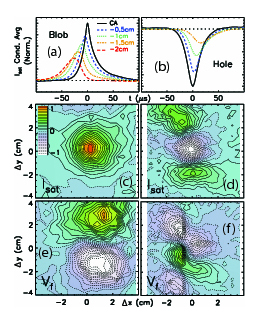
Intermittent turbulence, or turbulence that is "bursty" in time or "patchy" in space, is observed in the edge of almost all magnetic confinement laboratory devices. In these devices, the intermittency is the result of the generation and convective transport of coherent filamentary structures (often called "blobs" or "holes"). The convection of these structures significantly enhances cross-field particle transport and may play a role in the poorly understood Greenwald density limit in tokamaks.
I have been studying intermittent turbulence and turbulent structures in the Large Plasma Device (LAPD) at UCLA. The figure to the left shows two-dimensional cross-correlation images of the density and potential of turbulently generated structures in LAPD. The images show that the blobs are localized filamentary structures with a dipolar potential while the holes are part of a more extended turbulent structure (T.A. Carter, Phys. Plasmas 13, 010701 (2006)). Future work will focus on the mechanism by which the structures are generated,in particular exploring the role of sheared cross-field flows in collaboration with Prof. Mark Gilmore (UNM).
For information on other plasma physics research activities at UCLA, visit the Plasma Science and Technology Institute website.